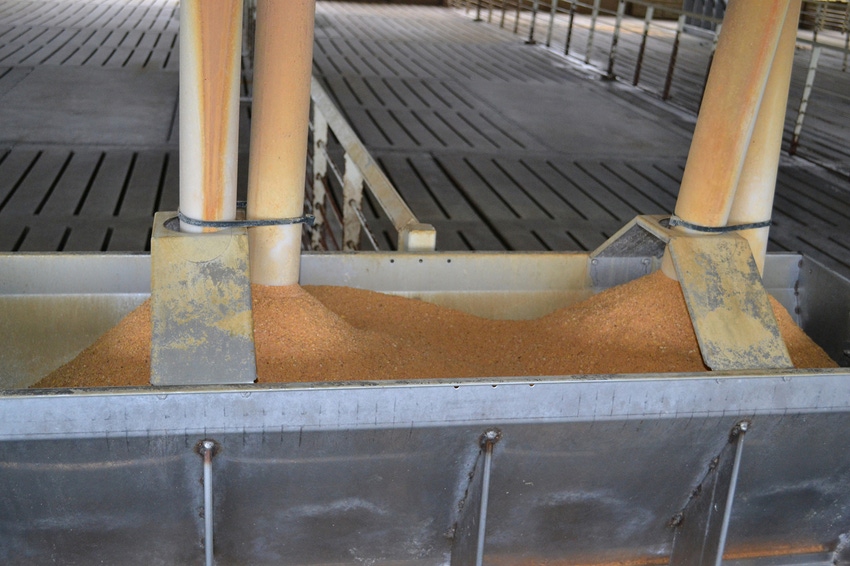Fiber has become an increasingly important topic in swine nutrition, specifically how does fiber impact other components of the diet.
February 1, 2018

By John Patience, Iowa State University Department of Animal Science Professor
Over the past decade, fiber has evolved into an increasingly important topic in swine nutrition. Prior to 2008, there was little interest in fiber because most commonly used ingredients contained very low levels. When ethanol production emerged as a major market for corn, the pork industry was forced to use the fermentation byproduct — distillers dried grains and distillers dried grains with solubles. Suddenly the neutral detergent fiber content of typical pig diets increased from 5% to 15% or even 20%.
Many questions emerged as a result of this change. How well can pigs use this fiber? Is fiber digested in the small intestine or is it fermented in the cecum and large intestine? This is important because digestion is energetically more efficient than fermentation. What can be done to improve the utilization of fiber? Does fiber alter digestion of other components of the diet?
More recently, questions arose about fiber for a different reason. Could fiber be used to improve gut health, and if so, how could it be done in a predictable manner? This coincided with the recognition that when we formulate diets for pigs, we are supplying more than nutrients like amino acids, minerals and vitamins. Different ingredients alter the functioning of the gut, and the impact can be either positive or negative.
Before delving into these questions, let’s look at a few basic facts about fiber. While there are many ways to analyze a diet for fiber, none of the available assays do a really good job of explaining the physiological effect of fiber in the gut. It is widely accepted that crude fiber provides little useful information and many labs have stopped using it.
Neutral detergent fiber and acid detergent fiber are more commonly used, as they provide more useful information, but they are far from perfect. NDF essentially measures the cellulose, hemicellulose and lignin content of a diet or ingredient. ADF measures cellulose and lignin.
Hemicellulose, cellulose and lignin are all found in the cell walls of ingredients; the higher their level, the poorer will be the digestion of that ingredient. Cellulose and lignin are not digested by enzymes present in the gut, and are very poorly fermented in the cecum and large intestine. Hemicellulose is also not digested by the pig, but some breakdown by fermentation does occur. NDF measures, in approximate terms, insoluble fiber in the diet; in most cases, insoluble fiber is poorly fermented.
Some labs measure what is called total dietary fiber; this assay is slow and laborious and thus expensive. TDF measures both insoluble and soluble fiber. The soluble fiber may be quite well fermented and thus provides some useful energy to the pig; however, to complicate things, not all soluble fiber is well fermented. It will depend on the exact composition of the fiber. Soluble fiber includes things like undigested starch, B-glucans (found largely in barley), pectins and gums.
For practical diets, the NDF assay is probably the best option. It is reasonably inexpensive and provides information on the component of fiber that is poorly fermented. To practical nutritionists, there are two main problems with the NDF assay. First, it is prone to variability, so results can vary from lab to lab. Second, it provides no information on soluble fiber that can be a problem if one is evaluating an ingredient for it prebiotic effects, as explained below. Researchers solve the problem somewhat by using the TDF assay and by measuring soluble versus insoluble fiber. They may also measure individual sugars. At the present time, these assays are too expensive to be used on a routine basis.
It is known that as fiber levels increase in the diet, the availability of certain nutrients, such as amino acids and minerals may go down, as will fat digestibility. However, this has not yet been quantified so adjusting the nutrient content of a diet due to its fiber content is currently more art than science.
It is also known that increased fermentable fiber in the diet increases the requirement for threonine. However, the increase is relatively modest in most situations.
So far, we have discussed the problems associated with elevated fiber in the diet. However, we are increasingly aware that fiber can be a positive factor in the diet because it can improve gut health. Much of the benefit accrues from fiber that is easily fermented rather than fiber that is poorly fermented. We have data showing that pig performance may be improved when exposed to a pathogenic e. coli challenge when fermentable soluble fiber is included in the diet, much more so than when poorly fermented fiber is present. More research is required in this area, but it is clear that the health of the young pig can be improved by increasing the levels of fermentable fiber in the diet.
I hope this very brief primer on fiber has been helpful, and I hope it has not been too confusing. It is not an easy topic to get one’s head around. But because of its increasing importance, it is a topic that needs to be reasonably well understood in order to formulate diets most effectively.
You May Also Like



